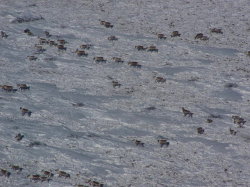Summary
This analysis will assess the use of winter range by the WACH, identify potential winter range, contrast burned and unburned habitat, summarize the fire regime within the herd's range, model the impacts of warming and fire management on extent of winter range, and develop management recommendations based on these findings.
Habitat use will be assessed by comparing locations recorded by satellite telemetry collars to available habitat mapping products. Differences between used and random locations, burned and unburned locations, and current, historic and potential winter range will be assessed using vegetative data collected from field studies.

The regional fire regime will be summarized by reviewing existing literature and analyzing AFS' large fire database.
Summary weather data will be compared to fire extent to reveal potential correlations. Modeling efforts, using various potential warming scenarios and fire management options, will be undertaken to understand how the extent and quality of winter range may change over time. Vegetation data from the field studies and fire regime data summary analysis will be employed to improve these modeling efforts. The analyses and findings will be synthesized to develop management recommendations for caribou and fire management in the region.
Results
Applications
The results will be used to guide the management of the Western Arctic Caribou Herd and also to develop a Fire Management Plan for Northwest Alaska.
Reports
Joly, K., Jandt, R.R., Meyers, C.R., and Cole, M.J. 2007. Changes in vegetative cover on Western Arctic herd winter range from 1981-2005: Potential effects of grazing and climate change. Rangifer Special Issue 17:199-207.Download (1.07 MB)
Joly, K, Bente, P and Dau, J. 2007. Response of Overwintering Caribou to Burned Habitat in Northwest Alaska. Arctic Vol 60 No 4, p 401-410 Download (2.07 MB)
JOLY, K., David R. Klein, David L. Verbyla, T. Scott Rupp and F. Stuart Chapin III. 2011. Linkages between large-scale climate patterns and the dynamics of Arctic Caribou Populations. Download (205kb)
Joly, K., M. J. Cole, and R. R. Jandt. 2007. Diets of overwintering caribou, Rangifer tarandus, track decadal changes in arctic tundra vegetation. Canadian Field-Naturalist 121 (4): 379-383. Download (502 kB)
Jandt, R, K. Joly, C. R. Myers. 2008. Slow Recovery of Lichen. on Burned Caribou Winter Range in Alaska Tundra: Potential Influences of Climate Warming and Other Disturbance Factors. Arctic Antarctic and Alpine Research, Vol 40: # 1, p 89-95 Download (811 kB)
Joly, K., T. S. Rupp, R. R. Jandt, and F. S. Chapin III. 2009. Fire in the range of the Western Arctic Caribou Herd. Alaska Park Science 8 (2):68-73. Download (360 kB)
Joly, K., R. R. Jandt, and D. R. Klein. 2009. Decrease of lichens in arctic ecosystems: role of wildfire, caribou and reindeer, competition, and climate change. Polar Research 28 (3):433-442. Download (447 kB)
Kyle Joly,F. Stuart Chapin III & David R. Klein. 2010. Winter habitat selection by caribou in relation to lichen abundance, wildfires, grazing, and landscape characteristics in northwest Alaska. Ecoscience (17(3):321-333.Download (2.62 MB)
Contacts
Kyle Joly
Wildlife Biologist
Gates of the Arctic National Park and Preserve Yukon-Charley Rivers National Preserve
4175 Geist Road
Fairbanks, AK 99709
907-455-0626
kyle_joly 'at' nps.gov

